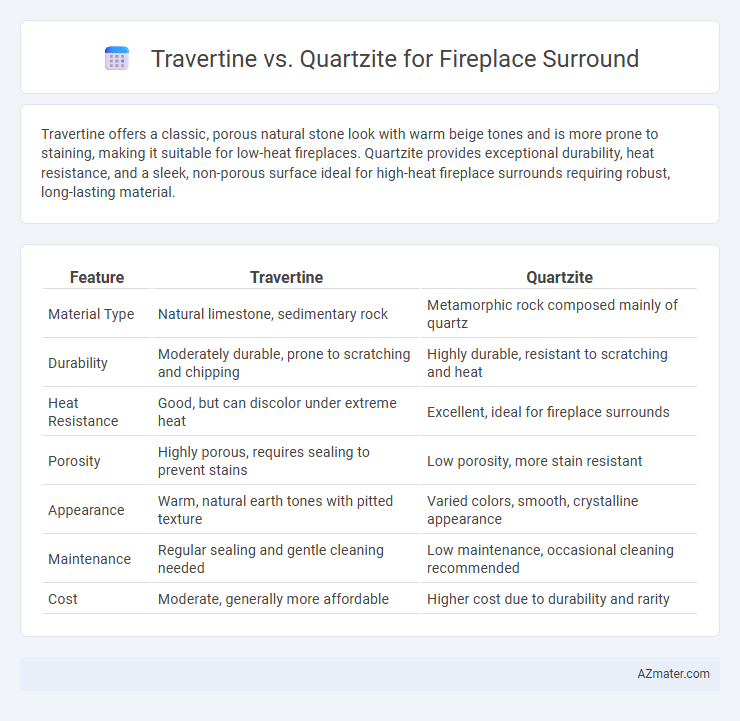Travertine offers a classic, porous natural stone look with warm beige tones and is more prone to staining, making it suitable for low-heat fireplaces. Quartzite provides exceptional durability, heat resistance, and a sleek, non-porous surface ideal for high-heat fireplace surrounds requiring robust, long-lasting material.
Table of Comparison
| Feature | Travertine | Quartzite |
|---|---|---|
| Material Type | Natural limestone, sedimentary rock | Metamorphic rock composed mainly of quartz |
| Durability | Moderately durable, prone to scratching and chipping | Highly durable, resistant to scratching and heat |
| Heat Resistance | Good, but can discolor under extreme heat | Excellent, ideal for fireplace surrounds |
| Porosity | Highly porous, requires sealing to prevent stains | Low porosity, more stain resistant |
| Appearance | Warm, natural earth tones with pitted texture | Varied colors, smooth, crystalline appearance |
| Maintenance | Regular sealing and gentle cleaning needed | Low maintenance, occasional cleaning recommended |
| Cost | Moderate, generally more affordable | Higher cost due to durability and rarity |
Introduction to Fireplace Surround Materials
Travertine and quartzite are popular natural stone choices for fireplace surrounds, each offering distinct aesthetic and durability qualities. Travertine provides a warm, porous texture with unique pitting and veining, ideal for rustic or traditional designs, while quartzite offers exceptional hardness and resistance to heat and scratches, making it suitable for high-traffic or modern spaces. Selecting between travertine and quartzite for a fireplace surround depends on factors like desired appearance, maintenance requirements, and thermal performance.
What is Travertine?
Travertine is a natural sedimentary rock formed by the precipitation of calcium carbonate in mineral springs, known for its porous texture and warm, earthy tones ideal for rustic and traditional fireplace surrounds. Its durability and unique surface patterns provide a natural aesthetic, but it requires sealing to prevent staining and damage from heat exposure. Compared to quartzite, travertine offers a softer, more textured appearance, making it a popular choice for decorative fireplace designs seeking natural warmth.
What is Quartzite?
Quartzite is a natural metamorphic rock formed from sandstone subjected to intense heat and pressure, resulting in a durable and dense material ideal for fireplace surrounds. Its high resistance to heat, scratches, and weathering makes it a practical and long-lasting choice for both indoor and outdoor applications. Unlike travertine, which is a softer, porous limestone, quartzite offers superior strength and minimal maintenance, providing a sleek and elegant surface for fireplaces.
Aesthetic Appeal: Travertine vs Quartzite
Travertine offers a warm, porous texture with natural pits and veins that create a timeless, rustic aesthetic ideal for cozy fireplace surrounds. Quartzite features a harder, denser structure with a glossy finish and vibrant, swirling patterns, lending a modern and elegant look. Both materials provide unique visual appeal, but travertine emphasizes earthy charm while quartzite highlights luxurious sophistication.
Durability Comparison
Quartzite offers superior durability for fireplace surrounds due to its natural resistance to heat, scratching, and chipping compared to travertine. Travertine, a softer limestone, is more porous and prone to etching, making it less ideal for high-temperature areas. Quartzite's density and hardness provide a long-lasting, low-maintenance surface that withstands the thermal stress of fireplace environments.
Heat Resistance and Safety
Travertine offers moderate heat resistance suitable for fireplace surrounds but may develop cracks under prolonged high temperatures due to its porous nature. Quartzite exhibits superior heat resistance with low thermal conductivity, making it a safer option for intense heat exposure around fireplaces. Choosing quartzite enhances fire safety and durability, reducing risks of thermal damage compared to travertine.
Maintenance Requirements
Travertine requires regular sealing and gentle cleaning to prevent staining and etching from fireplace soot and heat exposure, as it is a porous natural stone. Quartzite, being more dense and hard, offers superior resistance to heat, scratches, and staining, requiring less frequent sealing and easier maintenance for a fireplace surround. Both materials need dusting and wiping with non-abrasive cleaners, but quartzite's durability makes it a more practical, low-maintenance choice for high-traffic or heat-exposed areas.
Cost and Value Considerations
Travertine offers a lower upfront cost for fireplace surrounds, making it an attractive option for budget-conscious homeowners, while quartzite typically demands a higher price due to its durability and natural hardness. Quartzite's superior resistance to heat and scratches provides better long-term value by maintaining its appearance and structural integrity in high-heat environments. Considering maintenance costs and lifespan, quartzite often proves more cost-effective over time compared to the softer, more porous travertine which may require sealing and more frequent repairs.
Installation Process Differences
Travertine installation for fireplace surrounds requires sealing and filling its natural pores to prevent staining and moisture absorption, while quartzite demands less sealing due to its dense, non-porous surface. Travertine's softer composition makes cutting and shaping easier, but it is more prone to chipping and requires careful handling during installation. Quartzite, being harder and more durable, necessitates specialized tools like diamond blades for precise cutting, resulting in a more labor-intensive but long-lasting fireplace surround installation.
Which Material is Best for Your Fireplace Surround?
Travertine and quartzite are both popular choices for fireplace surrounds, but quartzite offers greater durability and heat resistance, making it ideal for high-temperature areas. Travertine provides a classic, rustic look with natural voids and a softer texture, but it requires more maintenance due to its porosity and lower hardness. For a long-lasting, low-maintenance fireplace surround that withstands heat well, quartzite is generally the best option.

Infographic: Travertine vs Quartzite for Fireplace Surround
 azmater.com
azmater.com